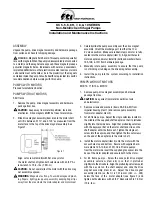
User manual
AKKU
TEC
2412 VdS
Document
page 10 / 16
0812G01B02-160422.docx
5.4
Accumulator circuit monitoring
In order to ensure the buffer capacity of the external energy supply, the accumulator circuit is tested in cycles
of 60 seconds; the first test is performed 60 seconds after connection to the mains. This test allows the detec-
tion of a possible interruption resp. high resistivity of the accumulator circuit.
In mains operation, a defective accumulator circuit is indicated by the LED
Bat-OK
going out, and the illumina-
tion of the LED
Error.
5.5
Accumulator test
A cyclic lead accumulator test which is performed during mains operation each 10 minutes, stresses the bat-
tery with simultaneous voltage measurement. This allows to give a statement about the internal resistance of
the accumulator.
A severely aged lead accumulator is indicated by the LED
Bat-OK
going out and the illumination of the
LED
Error
in mains operation.
NOTE
The lead accumulator test serves to detect severely aged lead accumulators. In order to be able
to make a statement about the buffering ability of the lead accumulators in the present system, a
manual check of the lead accumulators is necessary in regular intervals! (See section
7
)
When the
AKKU
TEC
2412 VdS is delivered it is configurated for three different accumulator dimen-
sions. Herewith the limiting value for the measurement of the internal resistance is adjusted as follows:
1:
7 Ah -18 Ah 225
mΩ
2:
26 Ah -85 Ah 175
mΩ
3:
>65 Ah and at Master/Slave operation 125
mΩ
NOTE
The Windows-Software
para
TEC
VdS is available for the configuration of
AKKU
TEC
for special
requirements.
Special characteristics: Voltage, current, temperature monitoring, adaptation of internal re-
sistance threshold for different lead accumulator sizes, activation/deactivation for external fuse
board.
5.6
Temperature tracking (optional)
Lead accumulators have a temperature coefficient of approximately - 3 mV per °C and per cell.
For the usage without temperature sensor the final charging voltage of the external power supply is selected in
the way that charging the lead accumulators is ensured in a temperature range of 15 °C to 40 °C.
In applications with frequent and strong temperature variations, the charging voltage should be adjusted in
order to obtain maximum life duration of the lead accumulators. A temperature adjustment should be ensured
as well in particular in case of very low ambient temperatures (T
u
< 15 °C) in order to ensure sufficient lead
accumulator charge. The temperature tracking is activated automatically by connecting the external tempera-
ture sensor (optional module) to terminal
1
and
2
of the terminal strip
IO-2
. Depending on the ambient temper-
ature variation of -10 to 50 °C, the deep discharge voltage (and thus, also the output voltage) varies in a range
of 28.6 V to 26.4 V DC (27.36 V at 25 °C).
A lead accumulator temperature above 45 °C is registered by the power supply and forwarded to the monitor-
ing software
para
TEC
. The power supply however does not monitor this condition.
NOTE
To ensure a satisfyinglife duration of the lead accumulators, the operating temperature
of the lead accumulators should not exceed 20 °C. Higher temperatures lead to a drastic
decrease of the life duration resp. service life!
NOTE
Die VdS-regulation instructs a temperature tracking. For VdS conform operation a tem-
perature sensor must be connected to the power supply!


































